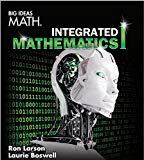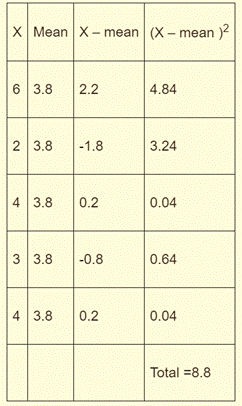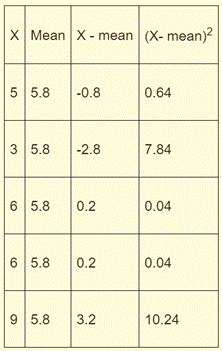
Concept explainers
The range and standard deviation of the given data set.
Answer to Problem 3Q
Range for the data for female:
Range for the data for male:
Standard Deviation for the data for female =
Standard Deviation for the data for male =
Explanation of Solution
Given:
The given data set is:
Calculation:
The range and standard deviation of the given data can be calculated as:
Order the given data set for female:
Range of the given data set is the difference between the largest and smallest data value.
Therefore, range for the data for female:
Order the given data set for male:
Therefore, range for the data for male:
Now, to find the standard deviation for female:
Step 1: Calculate the mean.
Mean =
Step 2: Calculate the deviation for each data value.
Step 3: Calculate the square of each deviation.
Step 4: Calculate the mean of squared deviations/variance.
Step 5: Make use of calculator to find the square roots of the variance.

Total =
Standard Deviation =
Now, to find the standard deviation for male:
Step 1: Calculate the mean.
Mean =
Step 2: Calculate the deviation for each data value.
Step 3: Calculate the square of each deviation.
Step 4: Calculate the mean of squared deviations/variance.
Step 5: Make use of calculator to find the square roots of the variance.

Total =
Standard Deviation =
Chapter 7 Solutions
BIG IDEAS MATH Integrated Math 1: Student Edition 2016
- For a binary asymmetric channel with Py|X(0|1) = 0.1 and Py|X(1|0) = 0.2; PX(0) = 0.4 isthe probability of a bit of “0” being transmitted. X is the transmitted digit, and Y is the received digit.a. Find the values of Py(0) and Py(1).b. What is the probability that only 0s will be received for a sequence of 10 digits transmitted?c. What is the probability that 8 1s and 2 0s will be received for the same sequence of 10 digits?d. What is the probability that at least 5 0s will be received for the same sequence of 10 digits?arrow_forwardV2 360 Step down + I₁ = I2 10KVA 120V 10KVA 1₂ = 360-120 or 2nd Ratio's V₂ m 120 Ratio= 360 √2 H I2 I, + I2 120arrow_forwardQ2. [20 points] An amplitude X of a Gaussian signal x(t) has a mean value of 2 and an RMS value of √(10), i.e. square root of 10. Determine the PDF of x(t).arrow_forward
- exam review please help!arrow_forwardA linear programming computer package is needed. As part of the settlement for a class action lawsuit, Hoxworth Corporation must provide sufficient cash to make the following annual payments (in thousands of dollars). Year 1 2 2 3 4 5 6 Payment 210 235 260 305 335 480 The annual payments must be made at the beginning of each year. The judge will approve an amount that, along with earnings on its investment, will cover the annual payments. Investment of the funds will be limited to savings (at 4% annually) and government securities, at prices and rates currently quoted in The Wall Street Journal. Hoxworth wants to develop a plan for making the annual payments by investing in the following securities (par value = $1,000). Funds not invested in these securities will be placed in savings. Security Current Price Rate (%) Years to Maturity 1 2 $1,055 $1,000 6.750 5.125 3 4 Assume that interest is paid annually. The plan will be submitted to the judge and, if approved, Hoxworth will be…arrow_forwardFind the values of n, if the points (n + 1, 2n), (3n, 2n + 3) and (5n + 1,5n) are collinear. Find the value of k that the four points (4,1,2), (5, k, 6), (5,1,-1) and (7,4,0) are coplanar. Find the value of r if the area of the triangle is formed by the points (-3,6),(4,4) and (r,-2) is 12 sq units. Find the volume of tetrahedron whose vertices are A(1,1,0), B(-4,3,6), C(-1,0,3) and D(2,4,-5).arrow_forward
- A linear programming computer package is needed. Hanson Inn is a 96-room hotel located near the airport and convention center in Louisville, Kentucky. When a convention or a special event is in town, Hanson increases its normal room rates and takes reservations based on a revenue management system. A large professional organization has scheduled its annual convention in Louisville for the first weekend in June. Hanson Inn agreed to make at least 50% of its rooms available for convention attendees at a special convention rate in order to be listed as a recommended hotel for the convention. Although the majority of attendees at the annual meeting typically request a Friday and Saturday two-night package, some attendees may select a Friday night only or a Saturday night only reservation. Customers not attending the convention may also request a Friday and Saturday two-night package, or make a Friday night only or Saturday night only reservation. Thus, six types of reservations are…arrow_forwardexam review please help!arrow_forwardIn a network with 12 links, one of the links has failed. The failed link is randomlylocated. An electrical engineer tests the links one by one until the failed link is found.a. What is the probability that the engineer will find the failed link in the first test?b. What is the probability that the engineer will find the failed link in five tests?Note: You should assume that for Part b, the five tests are done consecutively.arrow_forward
- A linear programming computer package is needed. Epsilon Airlines services predominately the eastern and southeastern United States. A vast majority of Epsilon's customers make reservations through Epsilon's website, but a small percentage of customers make reservations via phone. Epsilon employs call-center personnel to handle these reservations along with any problems with the website reservation system and for the rebooking of flights for customers if their plans change or their travel is disrupted. Staffing the call center appropriately is a challenge for Epsilon's management team. Having too many employees on hand is a waste of money, but having too few results in very poor customer service and the potential loss of customers. Epsilon analysts have estimated the minimum number of call-center employees needed by day of week for the upcoming vacation season (June, July, and the first two weeks of August). These estimates are given in the following table. Day Minimum Number of…arrow_forwardind Original: 100-200 = 20,000 200400=20,000 80 602=3600 694761 =4 4x1.3225-6.29 4761/3600 = 1-3225 5.29-1058msy 6). The dose to the body was 200 mSv. Find the dose to the lung in mrem? W 200ms 20 2.15 and 8) A technique of 20 mAs, 40 kV produces a f4 Sy Find the dose to the Thyroid inarrow_forwardoriginal ssD 400x (100) 2 400 x (14)=100 34 10or (2)² = 100 × (0-85) = 100 x = 72.25 100x 40 72.25 =36.13 500 36.13 13.84 O. 7225 12x13.84≈ 166.08mAs 10) The dose of a radiograph was 100 mSv with a technique of: 10 mAs, 180 kV at 200 cm and tabletop. If the technique is changed to: 20 mAs, 153 kV at 100 cm using a 5:1 grid then find the new dose in rem to the Lungs. 11) A radiographic technique produces an exposure index of EI= 300 and TEI=600 at a source- to-image receptor distance (SID) of 200 cm, 100 kV, 5:1 grid using 10 mAs. If the technique is changed to 100 cm and 85 kV and 5 mAs with table top find the new exposure index? What is the value of DI? 10arrow_forward
 Discrete Mathematics and Its Applications ( 8th I...MathISBN:9781259676512Author:Kenneth H RosenPublisher:McGraw-Hill Education
Discrete Mathematics and Its Applications ( 8th I...MathISBN:9781259676512Author:Kenneth H RosenPublisher:McGraw-Hill Education Mathematics for Elementary Teachers with Activiti...MathISBN:9780134392790Author:Beckmann, SybillaPublisher:PEARSON
Mathematics for Elementary Teachers with Activiti...MathISBN:9780134392790Author:Beckmann, SybillaPublisher:PEARSON
 Thinking Mathematically (7th Edition)MathISBN:9780134683713Author:Robert F. BlitzerPublisher:PEARSON
Thinking Mathematically (7th Edition)MathISBN:9780134683713Author:Robert F. BlitzerPublisher:PEARSON Discrete Mathematics With ApplicationsMathISBN:9781337694193Author:EPP, Susanna S.Publisher:Cengage Learning,
Discrete Mathematics With ApplicationsMathISBN:9781337694193Author:EPP, Susanna S.Publisher:Cengage Learning, Pathways To Math Literacy (looseleaf)MathISBN:9781259985607Author:David Sobecki Professor, Brian A. MercerPublisher:McGraw-Hill Education
Pathways To Math Literacy (looseleaf)MathISBN:9781259985607Author:David Sobecki Professor, Brian A. MercerPublisher:McGraw-Hill Education





